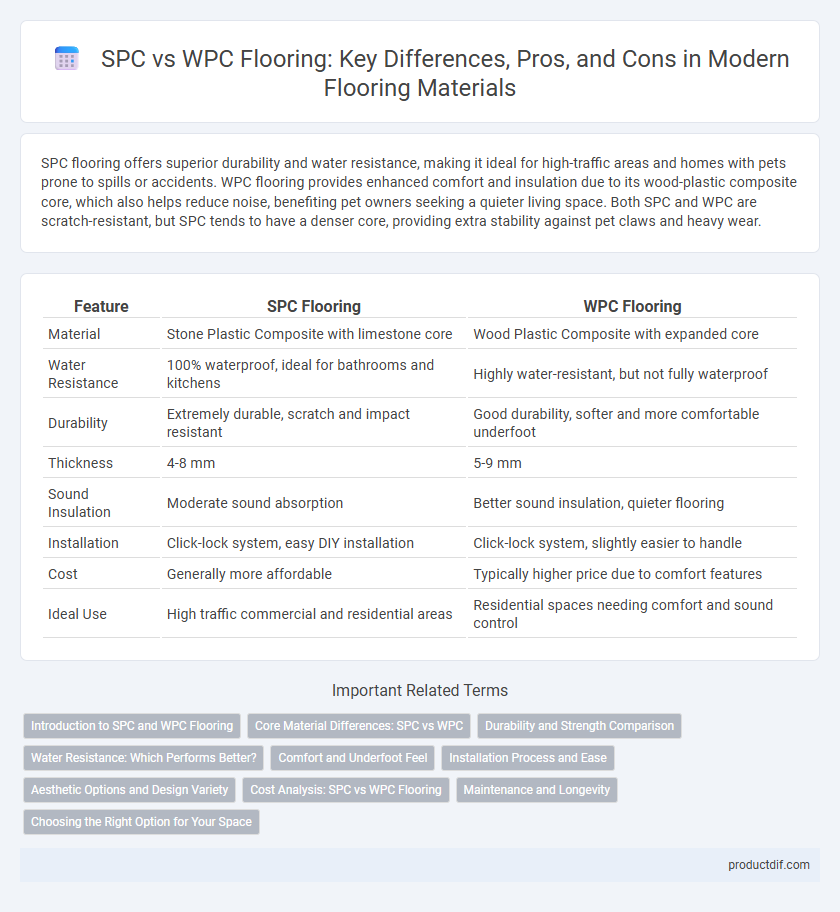SPC flooring offers superior durability and water resistance, making it ideal for high-traffic areas and homes with pets prone to spills or accidents. WPC flooring provides enhanced comfort and insulation due to its wood-plastic composite core, which also helps reduce noise, benefiting pet owners seeking a quieter living space. Both SPC and WPC are scratch-resistant, but SPC tends to have a denser core, providing extra stability against pet claws and heavy wear.
Table of Comparison
| Feature | SPC Flooring | WPC Flooring |
|---|---|---|
| Material | Stone Plastic Composite with limestone core | Wood Plastic Composite with expanded core |
| Water Resistance | 100% waterproof, ideal for bathrooms and kitchens | Highly water-resistant, but not fully waterproof |
| Durability | Extremely durable, scratch and impact resistant | Good durability, softer and more comfortable underfoot |
| Thickness | 4-8 mm | 5-9 mm |
| Sound Insulation | Moderate sound absorption | Better sound insulation, quieter flooring |
| Installation | Click-lock system, easy DIY installation | Click-lock system, slightly easier to handle |
| Cost | Generally more affordable | Typically higher price due to comfort features |
| Ideal Use | High traffic commercial and residential areas | Residential spaces needing comfort and sound control |
Introduction to SPC and WPC Flooring
SPC flooring features a rigid core made of stone plastic composite, offering enhanced durability, waterproof properties, and superior stability compared to traditional vinyl. WPC flooring utilizes a wood-plastic composite core that combines wood fibers and plastic, providing a softer, more cushioned feel underfoot with excellent water resistance. Both SPC and WPC flooring are popular choices for residential and commercial spaces due to their resilience, ease of maintenance, and stylish designs.
Core Material Differences: SPC vs WPC
SPC flooring features a Stone Plastic Composite core made of limestone, PVC, and stabilizers, providing exceptional rigidity and waterproof properties ideal for high-traffic areas. WPC flooring has a Wood Plastic Composite core combining wood fibers and plastic, offering a softer, warmer feel with enhanced sound insulation and comfort underfoot. The denser SPC core ensures greater durability and stability, while WPC cores excel in cushioning and moisture resistance, influencing installation choices based on environment and performance needs.
Durability and Strength Comparison
SPC flooring features a stone-plastic composite core that offers superior rigidity and impact resistance, making it highly durable for heavy traffic areas. WPC flooring incorporates a wood-plastic composite core, which provides enhanced comfort and sound absorption but slightly less strength compared to SPC. The mineral core in SPC isolates against dents and wear better than the foam core in WPC, resulting in longer-lasting performance under stress.
Water Resistance: Which Performs Better?
SPC flooring features a stone-plastic composite core, making it highly water-resistant and ideal for moisture-prone areas such as kitchens and bathrooms. WPC flooring has a wood-plastic composite core with a softer, thicker structure that offers some water resistance but is more susceptible to swelling and damage under prolonged water exposure. SPC outperforms WPC in water resistance due to its rigid, non-absorbent core, ensuring greater durability in wet environments.
Comfort and Underfoot Feel
SPC flooring features a rigid limestone composite core that offers exceptional durability but results in a firmer underfoot feel. WPC flooring incorporates a cushioned wood plastic composite core, providing enhanced comfort and a softer, more resilient walking experience. The added flexibility in WPC flooring makes it an ideal choice for spaces where comfort and noise reduction are priorities.
Installation Process and Ease
SPC flooring features a rigid core made of stone plastic composite, allowing for a straightforward click-lock installation with minimal subfloor preparation, ensuring a fast and durable setup. WPC flooring, composed of a wood-plastic composite core, offers more flexibility and better sound absorption but requires a more controlled installation environment to manage moisture and subfloor irregularities. Both flooring types provide DIY-friendly installation; however, SPC is often preferred for high-traffic areas due to its sturdier core and ease of installation on uneven surfaces.
Aesthetic Options and Design Variety
SPC flooring offers a wide range of aesthetic options including realistic wood, stone, and tile looks with high-definition printing technology that enhances texture and color depth. WPC flooring provides diverse design varieties with a thicker core allowing for more intricate patterns and embossed finishes that mimic natural materials. Both SPC and WPC flooring deliver extensive design versatility, but WPC typically offers more dimensional textures, while SPC excels in visual detail and color accuracy.
Cost Analysis: SPC vs WPC Flooring
SPC flooring typically costs between $2 to $4 per square foot, making it a more budget-friendly option compared to WPC flooring, which ranges from $3 to $6 per square foot. SPC offers higher durability and water resistance at a lower price point, whereas WPC provides better sound insulation and comfort but at a premium cost. The overall cost-effectiveness depends on the specific project requirements, with SPC favored for heavy-traffic areas and WPC ideal for residential spaces prioritizing comfort.
Maintenance and Longevity
SPC flooring, composed of stone plastic composite, offers superior durability and low maintenance due to its rigid core resistant to dents, scratches, and moisture. WPC flooring, made from wood plastic composite, provides better comfort underfoot but requires more frequent cleaning to prevent surface wear and potential moisture damage. Both materials are long-lasting, but SPC flooring generally outperforms WPC in terms of maintenance ease and lifespan under heavy use conditions.
Choosing the Right Option for Your Space
SPC (Stone Plastic Composite) flooring offers superior durability and water resistance, making it ideal for high-traffic areas and moisture-prone spaces like kitchens and bathrooms. WPC (Wood Plastic Composite) flooring provides a softer, more comfortable underfoot feel with better sound absorption, suitable for bedrooms and living rooms where comfort is a priority. Assessing factors such as foot traffic, moisture exposure, and desired comfort level helps determine whether SPC's rigidity or WPC's cushioning aligns best with your space requirements.
SPC vs WPC Flooring Infographic

 productdif.com
productdif.com